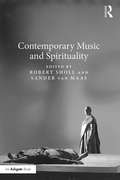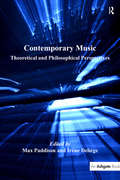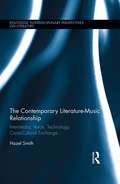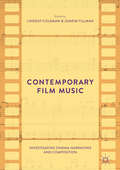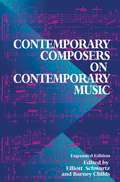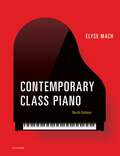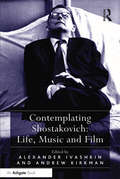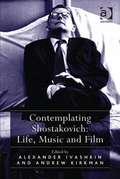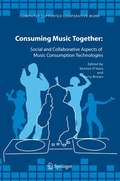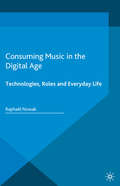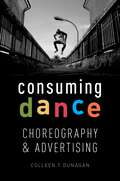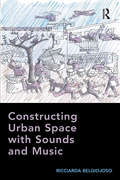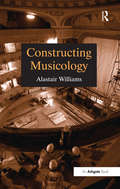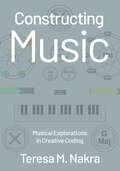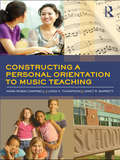- Table View
- List View
Contemporary Music and Spirituality
by Robert Sholl Sander Van MaasThe flourishing of religious or spiritually-inspired music in the late twentieth and early twenty-first centuries remains largely unexplored. The engagement and tensions between modernism and tradition, and institutionalized religion and spirituality are inherent issues for many composers who have sought to invoke spirituality and Otherness through contemporary music. Contemporary Music and Spirituality provides a detailed exploration of the recent and current state of contemporary spiritual music in its religious, musical, cultural and conceptual-philosophical aspects. At the heart of the book are issues that consider the role of secularization, the claims of modernity concerning the status of art, and subjective responses such as faith and experience. The contributors provide a new critical lens through which it is possible to see the music and thought of Cage, Ligeti, Messiaen, Stockhausen as spiritual music. The book surrounds these composers with studies of and by other composers directly associated with the idea of spiritual music (Harvey, Gubaidulina, MacMillan, Pärt, Pott, and Tavener), and others (Adams, Birtwistle, Ton de Leeuw, Ferneyhough, Ustvolskaya, and Vivier) who have created original engagements with the idea of spirituality. Contemporary Music and Spirituality is essential reading for humanities scholars and students working in the areas of musicology, music theory, theology, religious studies, philosophy of culture, and the history of twentieth-century culture.
Contemporary Music and Spirituality
by Robert Sholl Sander Van MaasThe flourishing of religious or spiritually-inspired music in the late twentieth and early twenty-first centuries remains largely unexplored. The engagement and tensions between modernism and tradition, and institutionalized religion and spirituality are inherent issues for many composers who have sought to invoke spirituality and Otherness through contemporary music. Contemporary Music and Spirituality provides a detailed exploration of the recent and current state of contemporary spiritual music in its religious, musical, cultural and conceptual-philosophical aspects. At the heart of the book are issues that consider the role of secularization, the claims of modernity concerning the status of art, and subjective responses such as faith and experience. The contributors provide a new critical lens through which it is possible to see the music and thought of Cage, Ligeti, Messiaen, Stockhausen as spiritual music. The book surrounds these composers with studies of and by other composers directly associated with the idea of spiritual music (Harvey, Gubaidulina, MacMillan, Pärt, Pott, and Tavener), and others (Adams, Birtwistle, Ton de Leeuw, Ferneyhough, Ustvolskaya, and Vivier) who have created original engagements with the idea of spirituality. Contemporary Music and Spirituality is essential reading for humanities scholars and students working in the areas of musicology, music theory, theology, religious studies, philosophy of culture, and the history of twentieth-century culture.
Contemporary Music: Theoretical and Philosophical Perspectives
by Irène DeliègeThis collection of essays and interviews addresses important theoretical, philosophical and creative issues in Western art music at the end of the twentieth- and the beginning of the twenty-first centuries. Edited by Max Paddison and Irène Deliège, the book offers a wide range of international perspectives from prominent musicologists, philosophers and composers, including Célestin Deliège, Pascal Decroupet, Richard Toop, Rudolf Frisius, Alastair Williams, Herman Sabbe, François Nicolas, Marc Jimenez, Anne Boissière, Max Paddison, Hugues Dufourt, Jonathan Harvey, and new interviews with Pierre Boulez, Brian Ferneyhough, Helmut Lachenmann, and Wolfgang Rihm. Part I is mainly theoretical in emphasis. Issues addressed include the historical rationalization of music and technology, new approaches to the theorization of atonal harmony in the wake of Spectralism, debates on the 'new complexity', the heterogeneity, pluralism and stylistic omnivorousness that characterizes music in our time, and the characterization of twentieth-century and contemporary music as a 'search for lost harmony'. The orientation of Part II is mainly philosophical, examining concepts of totality and inclusivity in new music, raising questions as to what might be expected from an autonomous contemporary musical logic, and considering the problem of the survival of the avant-garde in the context of postmodernist relativism. As well as analytic philosophy and cognitive psychology, critical theory features prominently, with theories of social mediation in music, new perspectives on the concept of musical material in Adorno's late aesthetic theory, and a call for 'an aesthetics of risk' in contemporary art as a means 'to reassert the essential role of criticism, of judgment, and of evaluation as necessary conditions to bring about a real public debate on the art of today'. Part III offers creative perspectives, with new essays and interviews from important contemporary composers who have mad
Contemporary Music: Theoretical and Philosophical Perspectives
by Irène DeliègeThis collection of essays and interviews addresses important theoretical, philosophical and creative issues in Western art music at the end of the twentieth- and the beginning of the twenty-first centuries. Edited by Max Paddison and Irène Deliège, the book offers a wide range of international perspectives from prominent musicologists, philosophers and composers, including Célestin Deliège, Pascal Decroupet, Richard Toop, Rudolf Frisius, Alastair Williams, Herman Sabbe, François Nicolas, Marc Jimenez, Anne Boissière, Max Paddison, Hugues Dufourt, Jonathan Harvey, and new interviews with Pierre Boulez, Brian Ferneyhough, Helmut Lachenmann, and Wolfgang Rihm. Part I is mainly theoretical in emphasis. Issues addressed include the historical rationalization of music and technology, new approaches to the theorization of atonal harmony in the wake of Spectralism, debates on the 'new complexity', the heterogeneity, pluralism and stylistic omnivorousness that characterizes music in our time, and the characterization of twentieth-century and contemporary music as a 'search for lost harmony'. The orientation of Part II is mainly philosophical, examining concepts of totality and inclusivity in new music, raising questions as to what might be expected from an autonomous contemporary musical logic, and considering the problem of the survival of the avant-garde in the context of postmodernist relativism. As well as analytic philosophy and cognitive psychology, critical theory features prominently, with theories of social mediation in music, new perspectives on the concept of musical material in Adorno's late aesthetic theory, and a call for 'an aesthetics of risk' in contemporary art as a means 'to reassert the essential role of criticism, of judgment, and of evaluation as necessary conditions to bring about a real public debate on the art of today'. Part III offers creative perspectives, with new essays and interviews from important contemporary composers who have mad
The Contemporary Literature-Music Relationship: Intermedia, Voice, Technology, Cross-Cultural Exchange (Routledge Interdisciplinary Perspectives on Literature)
by Hazel SmithThis book explores the relationship between words and music in contemporary texts, examining, in particular, the way that new technologies are changing the literature-music relationship. It brings an eclectic and novel range of interdisciplinary theories to the area of musico-literary studies, drawing from the fields of semiotics, disability studies, musicology, psychoanalysis, music psychology, emotion and affect theory, new media, cosmopolitanism, globalization, ethnicity and biraciality. Chapters range from critical analyses of the representation of music and the musical profession in contemporary novels to examination of the forms and cultural meanings of contemporary intermedia and multimedia works. The book argues that conjunctions between words and music create emergent structures and meanings that can facilitate culturally transgressive and boundary- interrogating effects. In particular, it conceptualises ways in which word-music relationships can facilitate cross-cultural exchange as musico-literary miscegenation, using interracial sexual relationships as a metaphor. Smith also inspects the dynamics of improvisation and composition, and the different ways they intersect with performance. Furthermore, the book explores the huge changes that computer-based real-time algorithmic text and music generation are making to the literature-music nexus. This volume provides fascinating insight into the relationship between literature and music, and will be of interest to those fields as well as New Media and Performance Studies.
The Contemporary Literature-Music Relationship: Intermedia, Voice, Technology, Cross-Cultural Exchange (Routledge Interdisciplinary Perspectives on Literature)
by Hazel SmithThis book explores the relationship between words and music in contemporary texts, examining, in particular, the way that new technologies are changing the literature-music relationship. It brings an eclectic and novel range of interdisciplinary theories to the area of musico-literary studies, drawing from the fields of semiotics, disability studies, musicology, psychoanalysis, music psychology, emotion and affect theory, new media, cosmopolitanism, globalization, ethnicity and biraciality. Chapters range from critical analyses of the representation of music and the musical profession in contemporary novels to examination of the forms and cultural meanings of contemporary intermedia and multimedia works. The book argues that conjunctions between words and music create emergent structures and meanings that can facilitate culturally transgressive and boundary- interrogating effects. In particular, it conceptualises ways in which word-music relationships can facilitate cross-cultural exchange as musico-literary miscegenation, using interracial sexual relationships as a metaphor. Smith also inspects the dynamics of improvisation and composition, and the different ways they intersect with performance. Furthermore, the book explores the huge changes that computer-based real-time algorithmic text and music generation are making to the literature-music nexus. This volume provides fascinating insight into the relationship between literature and music, and will be of interest to those fields as well as New Media and Performance Studies.
Contemporary Film Music: Investigating Cinema Narratives and Composition
by Lindsay Coleman Joakim TillmanThe purpose of this book, through its very creation, is to strengthen the dialogue between practitioner and theorist. To that end, a film academic, a composer, and a composer/musicologist have collaborated as editors on this book, which is in turn comprised of interviews with composers alongside complementary chapters that focus on a particular feature of the composer’s approach or style, written by a musicologist or film academic who specializes in that particular element of the composer’s output. In the interview portions of this book, eight major film composers discuss their work from the early 1980s to the present day. The focus is on the practical considerations of film composition, the relationship each composer has with the moving image, technical considerations, personal motivations in composing, the relationships composers have with their directors, and their own creative processes. Contemporary Film Music also explores the contemporary influence of electronic music, issues surrounding the mixing of soundtracks, music theory, and the evolution of composers’ musical voices.
Contemporary Composers On Contemporary Music (Music Reprint Ser. #1978)
by Elliott Schwartz Barney Childs Jim FoxThis anthology of essays, interviews, and autobiographical pieces provides an invaluable overview of the evolution of contemporary music-from chromaticism, serialism, and indeterminacy to jazz, vernacular, electronic, and non-Western influences. Featuring classic essays by Stravinsky, Stockhausen, and Reich, as well as writings by lesser-known but equally innovative composers such as Jack Beeson, Richard Maxfield, and T. J. Anderson, this collection covers a broad range of styles and approaches. Here you will find Busoni's influential "Sketch of a New Esthetic of Music"; Partch's exploration of a new notation system; Babbitt's defense of advanced composition in his controversial "Who Cares If You Listen?"; and Pauline Oliveros's meditations on sound. Now updated with fifteen new composers including Michael Tippet, György Ligeti, Gunther Schuller, Ben Johnston, Sofia Gubaidulina, and William Bolcom, this important book gathers together forty-nine pieces-many out of print and some newly written for this volume-which serve as a documentary history of twentieth-century music, in theory and practice. Impassioned, provocative, and eloquent, these writings are as exciting and diverse as the music they discuss.
Contemporary Class Piano
by Elyse MachKnown for its richly diversified styles of repertoire and ensemble pieces and its abundance of creative materials, Contemporary Class Piano, Ninth Edition, includes the widest-ranging repertoire of solo and ensemble pieces available in any beginning piano text. Elyse Mach presents an abundant solo and ensemble repertoire-which includes classical pieces and folk, jazz, dance, and blues tunes-providing ample opportunities for students to improvise, transpose, harmonize, and compose accompaniments.
Contemplating Shostakovich: Life, Music and Film
by Andrew KirkmanContemplating Shostakovich marks an important new stage in the understanding of Shostakovich and his working environment. Each chapter covers aspects of the composer's output in the context of his life and cultural milieu. The contributions uncover 'outside' stimuli behind Shostakovich's works, allowing the reader to perceive the motivations behind his artistic choices; at the same time, the nature of those choices offers insights into the workings of the larger world - cultural, social, political - that he inhabited. Thus his often ostensibly quirky choices are revealed as responses - by turns sentimental, moving, sardonic and angry - to the particular conditions, with all their absurdities and contradictions, that he had to negotiate. Here we see the composer emerging from the role of tortured loner of older narratives into that of the gregarious and engaged member of his society that, for better and worse, characterized the everyday reality of his life. This invaluable collection offers remarkable new insight, in both depth and range, into the nature of Shostakovich's working circumstances and of his response to them. The collection contains the seeds for a wide range of new directions in the study of Shostakovich's works and the larger contexts of their creation and reception.
Contemplating Shostakovich: Life, Music and Film
by Andrew KirkmanContemplating Shostakovich marks an important new stage in the understanding of Shostakovich and his working environment. Each chapter covers aspects of the composer's output in the context of his life and cultural milieu. The contributions uncover 'outside' stimuli behind Shostakovich's works, allowing the reader to perceive the motivations behind his artistic choices; at the same time, the nature of those choices offers insights into the workings of the larger world - cultural, social, political - that he inhabited. Thus his often ostensibly quirky choices are revealed as responses - by turns sentimental, moving, sardonic and angry - to the particular conditions, with all their absurdities and contradictions, that he had to negotiate. Here we see the composer emerging from the role of tortured loner of older narratives into that of the gregarious and engaged member of his society that, for better and worse, characterized the everyday reality of his life. This invaluable collection offers remarkable new insight, in both depth and range, into the nature of Shostakovich's working circumstances and of his response to them. The collection contains the seeds for a wide range of new directions in the study of Shostakovich's works and the larger contexts of their creation and reception.
Contemplating Shostakovich: Life, Music and Film
by Alexander Ivashkin Andrew KirkmanContemplating Shostakovich marks an important new stage in the understanding of Shostakovich and his working environment. Each chapter covers aspects of the composer's output in the context of his life and cultural milieu. The contributions uncover 'outside' stimuli behind Shostakovich's works, allowing the reader to perceive the motivations behind his artistic choices; at the same time, the nature of those choices offers insights into the workings of the larger world - cultural, social, political - that he inhabited. Thus his often ostensibly quirky choices are revealed as responses - by turns sentimental, moving, sardonic and angry - to the particular conditions, with all their absurdities and contradictions, that he had to negotiate. Here we see the composer emerging from the role of tortured loner of older narratives into that of the gregarious and engaged member of his society that, for better and worse, characterized the everyday reality of his life. This invaluable collection offers remarkable new insight, in both depth and range, into the nature of Shostakovich's working circumstances and of his response to them. The collection contains the seeds for a wide range of new directions in the study of Shostakovich's works and the larger contexts of their creation and reception.
Contemplating Shostakovich: Life, Music and Film (PDF)
by Alexander Ivashkin Andrew KirkmanContemplating Shostakovich marks an important new stage in the understanding of Shostakovich and his working environment. Each chapter covers aspects of the composer's output in the context of his life and cultural milieu. The contributions uncover 'outside' stimuli behind Shostakovich's works, allowing the reader to perceive the motivations behind his artistic choices; at the same time, the nature of those choices offers insights into the workings of the larger world - cultural, social, political - that he inhabited. Thus his often ostensibly quirky choices are revealed as responses - by turns sentimental, moving, sardonic and angry - to the particular conditions, with all their absurdities and contradictions, that he had to negotiate. Here we see the composer emerging from the role of tortured loner of older narratives into that of the gregarious and engaged member of his society that, for better and worse, characterized the everyday reality of his life. This invaluable collection offers remarkable new insight, in both depth and range, into the nature of Shostakovich's working circumstances and of his response to them. The collection contains the seeds for a wide range of new directions in the study of Shostakovich's works and the larger contexts of their creation and reception.
Consuming Music Together: Social and Collaborative Aspects of Music Consumption Technologies (Computer Supported Cooperative Work #35)
by Barry Brown Kenton O'HaraListening to, buying and sharing music is an immensely important part of everyday life. Yet recent technological developments are increasingly changing how we use and consume music. This book collects together the most recent studies of music consumption, and new developments in music technology. It combines the perspectives of both social scientists and technology designers, uncovering how new music technologies are actually being used, along with discussions of new music technologies still in development. With a specific focus on the social nature of music, the book breaks new ground in bringing together discussions of both the social and technological aspects of music use. Chapters cover topics such as the use of the iPod, music technologies which encourage social interaction in public places, and music sharing on the internet. A valuable collection for anyone concerned with the future of music technology, this book will be of particular interest to those designing new music technologies, those working in the music industry, along with students of music and new technology.
Consuming Music in the Digital Age: Technologies, Roles and Everyday Life (Pop Music, Culture and Identity)
by Raphaël NowakThis book addresses the issue of music consumption in the digital era of technologies. It explores how individuals use music in the context of their everyday lives and how, in return, music acquires certain roles within everyday contexts and more broadly in their life narratives.
CONSUMING DANCE C: Choreography and Advertising
by Colleen T. DunaganDance in TV advertisements has long been familiar to Americans as a silhouette dancing against a colored screen, exhibiting moves from air guitar to breakdance tricks, all in service of selling the latest Apple product. But as author Colleen T. Dunagan shows in Consuming Dance, the advertising industry used dance to market items long before iPods. In this book, Dunagan lays out a comprehensive history and analysis of dance commercials to demonstrate the ways in which the form articulates with, informs, and reflects U.S. culture. In doing so, she examines dance commercials as cultural products, looking at the ways in which dance engages with television, film, and advertising in the production of cultural meaning. Throughout the book, Dunagan interweaves semiotics, choreographic analysis, cultural studies, and critical theory in an examination of contemporary dance commercials while placing the analysis within a historical context. She draws upon connections between individual dance-commercials and the discursive and production histories to provide a thorough look into brand identity and advertising's role in constructing social identities.
Consuming Dance: Choreography and Advertising
by Colleen T. DunaganDance in TV advertisements has long been familiar to Americans as a silhouette dancing against a colored screen, exhibiting moves from air guitar to breakdance tricks, all in service of selling the latest Apple product. But as author Colleen T. Dunagan shows in Consuming Dance, the advertising industry used dance to market items long before iPods. In this book, Dunagan lays out a comprehensive history and analysis of dance commercials to demonstrate the ways in which the form articulates with, informs, and reflects U.S. culture. In doing so, she examines dance commercials as cultural products, looking at the ways in which dance engages with television, film, and advertising in the production of cultural meaning. Throughout the book, Dunagan interweaves semiotics, choreographic analysis, cultural studies, and critical theory in an examination of contemporary dance commercials while placing the analysis within a historical context. She draws upon connections between individual dance-commercials and the discursive and production histories to provide a thorough look into brand identity and advertising's role in constructing social identities.
Constructing Urban Space with Sounds and Music
by Ricciarda BelgiojosoWhile we are used to looking around us, we are less used to listening to what happens around us. And yet, the noises we produce reveal our way of life, and learning to master them is a necessity. This book aims at drawing the reader’s attention to the sound of the urban environment. The topic is by its very nature complex, as it involves sounds and noises, urban space and social activities. Using an interdisciplinary approach, it examines a heterogeneous selection of experimentations from the domains of music, art and architecture. Significant case studies of pieces of music, public art works and scientific research in the field of urban planning are analyzed, investigating the methods that have been adopted and the aural processes that have been generated. It then uses the findings to reconstruct the underlying theories and practices and to show what might be drawn from these procedures applied to urban planning. The overall objective is to learn to build and enrich space with sound, arguing that there is a need to reconsider architecture and urban planning beyond building, and to look to the world of the arts and other disciplines. In doing so, the book guides the reader toward a sensorial architecture, and more generally toward consciously creating environmental architecture which is sustainable and connects with art and which diffuses a culture of sound.
Constructing Urban Space with Sounds and Music
by Ricciarda BelgiojosoWhile we are used to looking around us, we are less used to listening to what happens around us. And yet, the noises we produce reveal our way of life, and learning to master them is a necessity. This book aims at drawing the reader’s attention to the sound of the urban environment. The topic is by its very nature complex, as it involves sounds and noises, urban space and social activities. Using an interdisciplinary approach, it examines a heterogeneous selection of experimentations from the domains of music, art and architecture. Significant case studies of pieces of music, public art works and scientific research in the field of urban planning are analyzed, investigating the methods that have been adopted and the aural processes that have been generated. It then uses the findings to reconstruct the underlying theories and practices and to show what might be drawn from these procedures applied to urban planning. The overall objective is to learn to build and enrich space with sound, arguing that there is a need to reconsider architecture and urban planning beyond building, and to look to the world of the arts and other disciplines. In doing so, the book guides the reader toward a sensorial architecture, and more generally toward consciously creating environmental architecture which is sustainable and connects with art and which diffuses a culture of sound.
Constructing Musicology
by Alastair WilliamsThis title was first published in 2001: Unlike many other academic disciplines, musicology has been somewhat reluctant to explore the possibilities that critical theory might offer to our understanding of music and the ways in which we study it. In recent years, however, both the general impact of theory on humanities research and the wider repertoires now studied on music degree courses have urged a paradigm shift in musicology. Looking at both these trends, Alastair Williams examines and explains the theoretical issues raised by different musics, including the Western canon, popular music, folk music and music by women. A theoretically informed musicology, he argues, can reflect on its own procedures and create strategies for particular problems as they arise. In this sense the book offers a musicology under construction. To appreciate how theoretical discourses function and the interests they serve, it is important to understand their roots. Chapter One begins with a presentation of traditional musicology in the context of Joseph Kerman's call for a shift from fact-finding to critical interpretation. Discussion then moves to the scrutiny of the bourgeois tradition by Adorno and Dahlhaus. Chapter Two explores Kerman's critique of structural analysis, together with the impact of poststructuralism on musicology. Awareness of new repertoire and its consequences becomes evident as the book unfolds, with Chapter Three considering music by women and examining how gender is constructed in music. Chapter Four extends this discussion to the field of popular music and the ways in which this genre negotiates identity. Challenges to the dominant values are further explored as Chapter Five looks at how non-European cultures are presented in European music and reflects on perceptions of self and other in ethnomusicology. Chapter Six charts the emergence of modern subjectivity and its formations in music, arguing that musicology should not lose sight of modernity's critical resources.
Constructing Musicology (Routledge Revivals Ser.)
by Alastair WilliamsThis title was first published in 2001: Unlike many other academic disciplines, musicology has been somewhat reluctant to explore the possibilities that critical theory might offer to our understanding of music and the ways in which we study it. In recent years, however, both the general impact of theory on humanities research and the wider repertoires now studied on music degree courses have urged a paradigm shift in musicology. Looking at both these trends, Alastair Williams examines and explains the theoretical issues raised by different musics, including the Western canon, popular music, folk music and music by women. A theoretically informed musicology, he argues, can reflect on its own procedures and create strategies for particular problems as they arise. In this sense the book offers a musicology under construction. To appreciate how theoretical discourses function and the interests they serve, it is important to understand their roots. Chapter One begins with a presentation of traditional musicology in the context of Joseph Kerman's call for a shift from fact-finding to critical interpretation. Discussion then moves to the scrutiny of the bourgeois tradition by Adorno and Dahlhaus. Chapter Two explores Kerman's critique of structural analysis, together with the impact of poststructuralism on musicology. Awareness of new repertoire and its consequences becomes evident as the book unfolds, with Chapter Three considering music by women and examining how gender is constructed in music. Chapter Four extends this discussion to the field of popular music and the ways in which this genre negotiates identity. Challenges to the dominant values are further explored as Chapter Five looks at how non-European cultures are presented in European music and reflects on perceptions of self and other in ethnomusicology. Chapter Six charts the emergence of modern subjectivity and its formations in music, arguing that musicology should not lose sight of modernity's critical resources.
Constructing Music: Musical Explorations in Creative Coding
by Teresa M. NakraWhy does music exert such a strong pull on us? How does it work? Traditional courses in music fundamentals give students a basic understanding of the building blocks of music and how to put them together to make a result that produces an intended effect. Constructing Music: Musical Explorations in Creative Coding takes students a step further: through a series of step-by-step tutorials and lessons, author Teresa M. Nakra presents a new method for teaching music fundamentals that foregrounds creative coding practices and builds upon the computing skills that today's students already possess. By encouraging experimentation with computer code, this book gives students tools to actively investigate, simulate, and engage with the structure of music, ultimately leading to greater understanding about the processes that underlie music's power over us. Designed to support computer-based learning in tonal harmony, musicianship, and music theory, Constructing Music avoids the lens of Western music notation and instead explains music content through analogies with toy bricks and references ideas from creative technology, engineering, and design. Students also engage directly with the components of musical structure using editable short code "patches" developed in Max, a visual coding environment for interactive music, audio, and media. Dozens of patches accompany the book and allow readers to play with the building blocks of sound, reinforcing each topic by tinkering, modifying, and creating their own versions of the material. Each chapter explains core music theory concepts in detail and supports every description through code simulations, progressing through the topics with increasing complexity. In the final chapter, Nakra explores the questions and theories that emerge from the lessons, considering the role of music as a proto-form of AI and its impacts on emotion, wellness, and creativity.
Constructing Music: Musical Explorations in Creative Coding
by Teresa M. NakraWhy does music exert such a strong pull on us? How does it work? Traditional courses in music fundamentals give students a basic understanding of the building blocks of music and how to put them together to make a result that produces an intended effect. Constructing Music: Musical Explorations in Creative Coding takes students a step further: through a series of step-by-step tutorials and lessons, author Teresa M. Nakra presents a new method for teaching music fundamentals that foregrounds creative coding practices and builds upon the computing skills that today's students already possess. By encouraging experimentation with computer code, this book gives students tools to actively investigate, simulate, and engage with the structure of music, ultimately leading to greater understanding about the processes that underlie music's power over us. Designed to support computer-based learning in tonal harmony, musicianship, and music theory, Constructing Music avoids the lens of Western music notation and instead explains music content through analogies with toy bricks and references ideas from creative technology, engineering, and design. Students also engage directly with the components of musical structure using editable short code "patches" developed in Max, a visual coding environment for interactive music, audio, and media. Dozens of patches accompany the book and allow readers to play with the building blocks of sound, reinforcing each topic by tinkering, modifying, and creating their own versions of the material. Each chapter explains core music theory concepts in detail and supports every description through code simulations, progressing through the topics with increasing complexity. In the final chapter, Nakra explores the questions and theories that emerge from the lessons, considering the role of music as a proto-form of AI and its impacts on emotion, wellness, and creativity.
Constructing a Personal Orientation to Music Teaching
by Mark Robin Campbell Linda K Thompson Janet R. BarrettConstructing a Personal Orientation to Music Teaching promotes inquiry and reflection to facilitate teacher growth, lifelong learning and a disposition toward educational change. Strongly grounded in current theories and research in teacher education, the text engages readers in analyzing their own experiences in order to conceptualize the complexity of teaching; involves them in clarifying their reasons for seeking a career in teaching; supports their insights, questions, and reflections about their work; and promotes a reflective, critical attitude about schools in general as teachers are urged to think of themselves as change agents in school settings.
Constructing a Personal Orientation to Music Teaching
by Mark Robin Campbell Linda K Thompson Janet R. BarrettConstructing a Personal Orientation to Music Teaching promotes inquiry and reflection to facilitate teacher growth, lifelong learning and a disposition toward educational change. Strongly grounded in current theories and research in teacher education, the text engages readers in analyzing their own experiences in order to conceptualize the complexity of teaching; involves them in clarifying their reasons for seeking a career in teaching; supports their insights, questions, and reflections about their work; and promotes a reflective, critical attitude about schools in general as teachers are urged to think of themselves as change agents in school settings.
